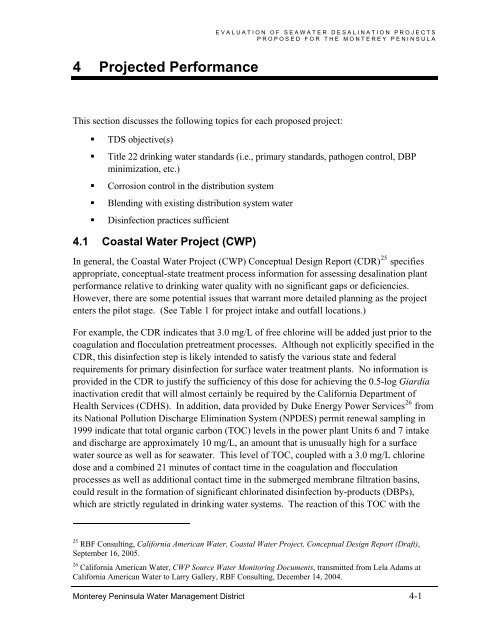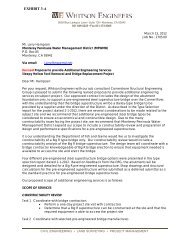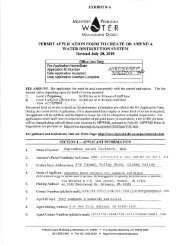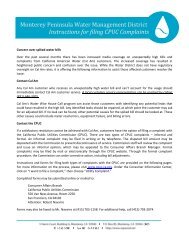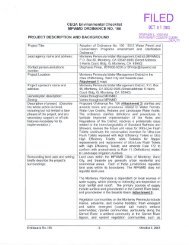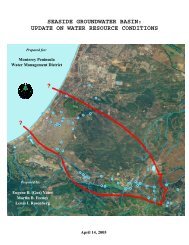FINAL REPORT Evaluation of Seawater Desalination Projects ...
FINAL REPORT Evaluation of Seawater Desalination Projects ...
FINAL REPORT Evaluation of Seawater Desalination Projects ...
Create successful ePaper yourself
Turn your PDF publications into a flip-book with our unique Google optimized e-Paper software.
EVALUATION OF SEAWATER DESALINATION PROJECTS<br />
PROPOSED FOR THE MONTEREY PENINSULA<br />
4 Projected Performance<br />
This section discusses the following topics for each proposed project:<br />
• TDS objective(s)<br />
• Title 22 drinking water standards (i.e., primary standards, pathogen control, DBP<br />
minimization, etc.)<br />
• Corrosion control in the distribution system<br />
• Blending with existing distribution system water<br />
• Disinfection practices sufficient<br />
4.1 Coastal Water Project (CWP)<br />
In general, the Coastal Water Project (CWP) Conceptual Design Report (CDR) 25 specifies<br />
appropriate, conceptual-state treatment process information for assessing desalination plant<br />
performance relative to drinking water quality with no significant gaps or deficiencies.<br />
However, there are some potential issues that warrant more detailed planning as the project<br />
enters the pilot stage. (See Table 1 for project intake and outfall locations.)<br />
For example, the CDR indicates that 3.0 mg/L <strong>of</strong> free chlorine will be added just prior to the<br />
coagulation and flocculation pretreatment processes. Although not explicitly specified in the<br />
CDR, this disinfection step is likely intended to satisfy the various state and federal<br />
requirements for primary disinfection for surface water treatment plants. No information is<br />
provided in the CDR to justify the sufficiency <strong>of</strong> this dose for achieving the 0.5-log Giardia<br />
inactivation credit that will almost certainly be required by the California Department <strong>of</strong><br />
Health Services (CDHS). In addition, data provided by Duke Energy Power Services 26 from<br />
its National Pollution Discharge Elimination System (NPDES) permit renewal sampling in<br />
1999 indicate that total organic carbon (TOC) levels in the power plant Units 6 and 7 intake<br />
and discharge are approximately 10 mg/L, an amount that is unusually high for a surface<br />
water source as well as for seawater. This level <strong>of</strong> TOC, coupled with a 3.0 mg/L chlorine<br />
dose and a combined 21 minutes <strong>of</strong> contact time in the coagulation and flocculation<br />
processes as well as additional contact time in the submerged membrane filtration basins,<br />
could result in the formation <strong>of</strong> significant chlorinated disinfection by-products (DBPs),<br />
which are strictly regulated in drinking water systems. The reaction <strong>of</strong> this TOC with the<br />
25 RBF Consulting, California American Water, Coastal Water Project, Conceptual Design Report (Draft),<br />
September 16, 2005.<br />
26 California American Water, CWP Source Water Monitoring Documents, transmitted from Lela Adams at<br />
California American Water to Larry Gallery, RBF Consulting, December 14, 2004.<br />
Monterey Peninsula Water Management District 4-1


